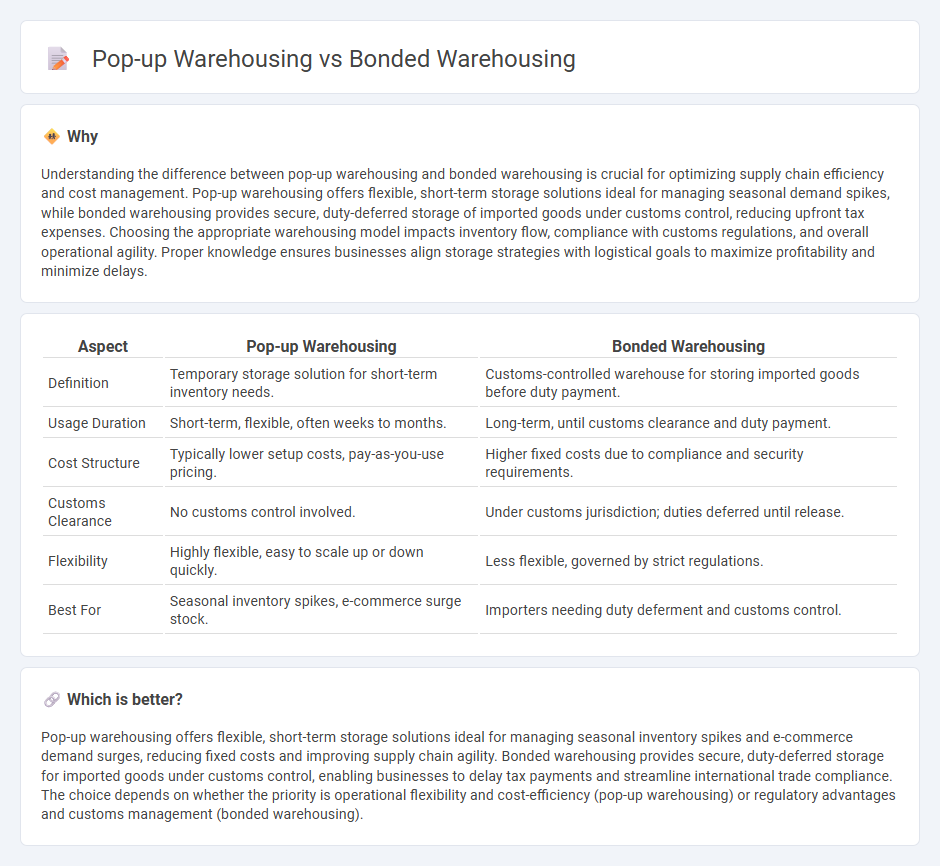
Pop-up warehousing offers flexible, temporary storage solutions ideal for seasonal demand spikes, enabling businesses to scale operations quickly without long-term commitments. Bonded warehousing involves secure storage of imported goods under customs supervision, allowing deferred payment of duties until goods are released for sale, optimizing cash flow. Explore the distinct advantages of pop-up and bonded warehousing to optimize your supply chain strategy.
Why it is important
Understanding the difference between pop-up warehousing and bonded warehousing is crucial for optimizing supply chain efficiency and cost management. Pop-up warehousing offers flexible, short-term storage solutions ideal for managing seasonal demand spikes, while bonded warehousing provides secure, duty-deferred storage of imported goods under customs control, reducing upfront tax expenses. Choosing the appropriate warehousing model impacts inventory flow, compliance with customs regulations, and overall operational agility. Proper knowledge ensures businesses align storage strategies with logistical goals to maximize profitability and minimize delays.
Comparison Table
| Aspect | Pop-up Warehousing | Bonded Warehousing |
|---|---|---|
| Definition | Temporary storage solution for short-term inventory needs. | Customs-controlled warehouse for storing imported goods before duty payment. |
| Usage Duration | Short-term, flexible, often weeks to months. | Long-term, until customs clearance and duty payment. |
| Cost Structure | Typically lower setup costs, pay-as-you-use pricing. | Higher fixed costs due to compliance and security requirements. |
| Customs Clearance | No customs control involved. | Under customs jurisdiction; duties deferred until release. |
| Flexibility | Highly flexible, easy to scale up or down quickly. | Less flexible, governed by strict regulations. |
| Best For | Seasonal inventory spikes, e-commerce surge stock. | Importers needing duty deferment and customs control. |
Which is better?
Pop-up warehousing offers flexible, short-term storage solutions ideal for managing seasonal inventory spikes and e-commerce demand surges, reducing fixed costs and improving supply chain agility. Bonded warehousing provides secure, duty-deferred storage for imported goods under customs control, enabling businesses to delay tax payments and streamline international trade compliance. The choice depends on whether the priority is operational flexibility and cost-efficiency (pop-up warehousing) or regulatory advantages and customs management (bonded warehousing).
Connection
Pop-up warehousing and bonded warehousing are connected through their roles in enhancing supply chain flexibility and cost-efficiency. Pop-up warehousing provides temporary storage solutions to manage demand fluctuations, while bonded warehousing allows goods to be stored without immediate customs duties, optimizing cash flow and inventory control. Both methods support efficient inventory management and expedited distribution in dynamic logistics environments.
Key Terms
**Bonded Warehousing:**
Bonded warehousing provides businesses with a secure facility to store imported goods without immediate payment of customs duties, allowing for deferred tax payments until the items are released into the domestic market. This method offers strategic advantages such as reduced cash flow burdens, compliance with customs regulations, and enhanced inventory management for international trade operations. Explore more about how bonded warehousing can optimize your global supply chain and cost efficiency.
Customs Control
Bonded warehousing provides secure storage for imported goods under Customs control, allowing deferred payment of duties and taxes until goods leave the warehouse, optimizing cash flow and compliance with regulations. Pop-up warehousing offers flexible, temporary storage solutions but lacks Customs supervision, making it unsuitable for bonded inventory or duty deferment. Explore more about how Customs Control impacts warehousing choices and supply chain efficiency.
Duty Deferment
Bonded warehousing allows importers to store goods without immediate payment of customs duties, enabling duty deferment until the products exit the warehouse for domestic use. Pop-up warehousing, typically short-term and flexible storage solutions, does not offer duty deferment benefits as it operates outside customs control. Explore how leveraging bonded warehousing can optimize cash flow in international supply chains.
Source and External Links
Bonded warehouse - A bonded warehouse is a secured facility where imported dutiable goods can be stored, manipulated, or undergo some manufacturing without immediate payment of duty, allowing goods to be re-exported or withdrawn after paying duty, with storage periods up to five years in some countries like the U.S.
Lineage Bonded Warehouses: Navigating Trade with Ease - Bonded warehouses offer secure, customs-regulated storage that allows importers to hold goods until tariffs are paid or import quotas reset, providing cost savings, compliance security, and strategic market entry advantages for quota-limited or seasonal products.
What are Bonded Warehouses and What are the Key ... - Bonded warehouses provide high-quality, secure storage for imported goods near ports, featuring security measures like CCTV and 24-hour monitoring and facilities for temperature control, preserving product quality until customs clearance.
 dowidth.com
dowidth.com